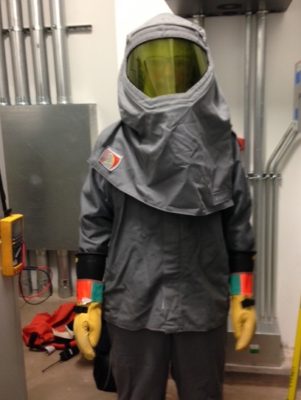
Prior to the 2018 version, NFPA 70E simply cautioned that “greater emphasis may be necessary with respect to de-energizing” equipment with incident energy (IE) exceeding 40 cal/cm2, “when exposed to electrical hazards.” This nebulous direction was applied within the industry by simply labeling everything over 40 cals as “Dangerous – No PPE Exists.”
In its new 2018 version, NFPA 70E eliminated this cautionary language. This may lead some to infer that working on energized equipment exceeding 40 cals is ok as long as they wear appropriately-rated PPE. But even though the standard may suggest that you could, for example, put on a 100 cal suit, the 64,000 “calorie” question is – should you?
Should You, Could You at 40.3?
So, why is “40” the magic number? Is there truly a greater risk when working on equipment with IE at 40.3 cals than that with 39.7 cals? Of course not. A hazard exists when working on anything greater than 1.2 cals (the threshold for a second-degree burn). Therefore, emphasis should always be placed on de-energizing rather than defining an arbitrary threshold to categorize manageably hazardous vs. too dangerous to even try.
 Should You, Could You in Full PPE?
Should You, Could You in Full PPE?
Another reason the 40 cal threshold is not a good indicator of actual risk is that it fails to consider other hazard-inducing factors, such as the duration of the arc. An arc that times out at 2 seconds is a “slow burn” compared to a 1/10th-of-a-second, rapidly expanding explosion complete with blast concussion and molten metal shrapnel. In that case, your PPE may protect you from the burn, but your eggs will still get scrambled.
Should You, Could You Change Your Approach?
To put it simply, if you can de-energize equipment before working on it, you should. This is, bar none, the safest approach. If you can’t shut down, it’s important to seriously consider whether to allow personnel to work on 40+ cal equipment. What are your objectives? Does your facility prioritize uptime over life-safety? What is your operations culture? What are your capabilities? Does your staff qualify as “qualified?” Should you bring in qualified local electrical contractors to work on equipment with higher IE? What are the potential risks and how will you mitigate them?
Should You, Could You Hire a Coach?
Whether you choose to allow your staff to work on equipment with high IE or not, there are several crucial considerations that need your attention; a power systems consultant specializing in arc flash mitigation can help you determine how to address these concerns.
The arc flash label
Standard practice prior to this revision has been to label equipment with an IE of over 40 cals as “Dangerous – No PPE Exists.” This labeling leaves room for, or even requires, interpretation by facility personnel. Since there are, in fact, PPE rated for 100 cals and higher, one individual may infer that the label is clearly wrong and assume it’s perfectly safe to don a PPE and do the work on energized equipment. Furthermore, if your facility does choose to allow staff to work on this equipment when energized, the label should clearly specify what PPE is required rather than leaving it to the staff member to guess.
The IE reported on the arc flash label should also be re-considered. Many times, only the worst-case condition is addressed, even if that scenario rarely or never actually occurs. I recommend working with your arc flash consultant to develop a label configuration that identifies IE and PPE requirements for multiple operating scenarios. For example, the worst-case IE scenario for your system might be when generators are running in parallel with the utility, but the label should also include IE levels for when your system is running in utility-only or generator-only modes. These other scenarios, which will have lower IE than the worst case, may give your staff some options based on actual operating conditions.
IE Reduction Tactics
In addition to these labeling modifications, Article 240.87 (B) of the 2017 NEC prescribes several methods for reducing incident energy including:
- Implementing Zone Selective Interlocking (ZSI), which is a hard-wired add-on solution that automatically overrides selective coordination settings; this is a very complex solution requiring engineering design, proper application and installation of proprietary hardware, and extensive testing & commissioning to verify functionality.
- Implementing an active arc flash mitigation system, which is a manufactured product that prioritizes incident energy over service continuity
- Retrofitting existing equipment with proprietary maintenance switches, allowing facility personnel to lower the IE with the push of a button
- Implementing a procedure for facility personnel to manually adjust the instantaneous trip setting, lowering the IE to a safer threshold
To employ any of these methods, rely on your coach to help you evaluate the options to determine if and how any of these methods could be implemented in your facility. Once you choose an approach, depend on your coach to:
- Help with planning, procurement, and implementation of a solution
- Modify your arc flash label to include dual incident energy results (one for worst-case scenario, the other for “maintenance mode”)
- Update your maintenance procedures, including a provision to switch back to standard operating settings
- Conduct safety and procedural training for your facility personnel
For more information about arc flash analysis and labeling, safety training, procedures development and implementation, or codes and standards in general, contact us to schedule a call with our power systems consultants.

